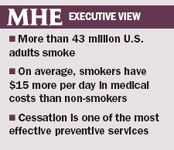Don't get complacent with smoking cessation
Smoking is the number-one preventable health risk, but quit rates have stalled


For a time, we seemed to be making progress. According to Morbidity and Mortality Weekly Report (Nov. 13, 2009), the proportion of U.S. adults who were cigarette smokers in 1998 declined from 24.1% to 19.8% in 2007.
Due to burgeoning public efforts to reduce tobacco prevalence, including the rise in smoking bans, increases in tobacco taxes, and the recent decision of Congress to allow the Food and Drug Administration to regulate tobacco, there is a general perception that smoking is a fading public health danger, according to the Associated Press.
In some states, however, there have been serious cuts to tobacco control programs. Between 2002 and 2005, there was a 28% decrease in funding for state tobacco programs. There have been even more dramatic cutbacks in 2009 in response to the economic crisis, with some states such as Washington, Wisconsin and Colorado at the forefront, cutting their programs by 40% to 80%.
Less than 3% of tobacco tax revenues and monies from the 1998 Master Settlement Agreement with tobacco companies go to prevention and quitting. In 2009, not a single state was funding tobacco control programs at the recommended CDC levels. In addition, coverage for tobacco treatment by healthcare insurers remains spotty at best around the country. Thus, there is a critical role for healthcare insurers, providers, and purchasers to play.
One might think that the recent 62-cent federal excise tax increase would have offered some relief; however, not a penny of the revenue generated from this increase has helped to fund tobacco prevention, control or treatment efforts. Medical professionals agree that people make quit attempts in response to large price increases-an observation backed up by the research of health economists.
However, the tax is a financial disincentive in the face of an addiction. Government, employers and health plans are in a position to offer treatment and financial support. This is particularly true as the government is becoming a direct benefactor of ongoing tobacco use from the revenue stream of increased taxation.
Extending the Capabilities of the EHR Through Automation
August 2nd 2023Welcome back to another episode of "Tuning In to the C-Suite," where Briana Contreras, an editor of Managed Healthcare Executive, had the pleasure of chatting with Cindy Gaines, chief clinical transformation officer at Lumeon.
Listen